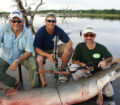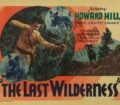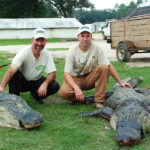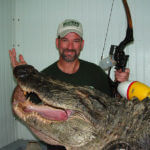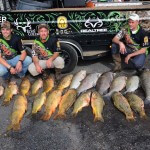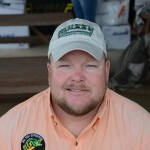Editor’s Note: Mark Land has been bowfishing since he was old enough to hold a bow. For 20 years, he worked for Muzzy and competed in bowfishing tournaments all over the nation.
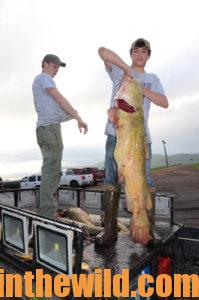 We were pre-bowfishing before the Jared Ashmore Youth Bowfishing Tournament (www.facebook.com/JarredAshmoreYouthBowfishingTournament) in Kentucky – an event that my buddy Andy Cardwell puts on every year that is strictly for kids. It is held on Father’s Day weekend, and it doesn’t cost anything for the kids to participate. Volunteers bring their bowfishing boats and equipment and take these young people out bowfishing. We’ll have about 200 youngsters and about 100 bowfishermen with their boats at this event.
We were pre-bowfishing before the Jared Ashmore Youth Bowfishing Tournament (www.facebook.com/JarredAshmoreYouthBowfishingTournament) in Kentucky – an event that my buddy Andy Cardwell puts on every year that is strictly for kids. It is held on Father’s Day weekend, and it doesn’t cost anything for the kids to participate. Volunteers bring their bowfishing boats and equipment and take these young people out bowfishing. We’ll have about 200 youngsters and about 100 bowfishermen with their boats at this event.
When I pre-bowfish this tournament, I try to find the easiest fish for the youngsters to shoot. Most of these kids never have shot bows before, and they’ve never been bowfishing. So, this tournament is a way to introduce young people to archery and to bowfishing. We try to find bighead carp and silver carp for the kids to shoot, because there are thousands of these fish in the river, and they can shoot an awful lot at these two species.
While pre-bowfishing, we spotted schools of fish roll-up on the surface when the generators were running the discharge water. Down in the water, I could see a huge gold-looking fish, and I thought it might be a giant goldfish. I’ve never seen a fish that looked like this one. After I saw it three or four times and tried to get in a position to shoot it, I spotted the fish directly under the boat, and I took the shot. When I finally got it to the surface, I saw it was an orange-colored bighead carp that weighed 48 pounds. Bighead carp are usually black on their backs and silver on their sides, but this one was solid orange and looked like a giant goldfish. Once I pulled it out of the water, I noticed that fish lost that vibrant gold and beautiful iridescent orange colors and turned almost yellow. It was a lustic or mirror carp. Many people called this unusual bighead an albino carp. However, this color phase of carp was not really that of an albino. The fish wasn’t all white with pink eyes like most albinos.
The most-memorable bowfishing tournament that I’d ever fished happened right after I started working 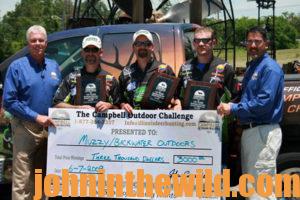 for Muzzy, and was because I’d always wanted to go to Michigan and shoot the Great Lakes Bowfishing Tournament (www.glbc-caseville.com). At that time, the Michigan tournament was the longest, continuously-running bowfishing tournament in the nation. So, I talked John Musacchia, one of the original owners of Muzzy, into going with me to this tournament. We took a motor home, traveled to Michigan and went to a place where we’d never shot fish before. We registered for the tournament.
for Muzzy, and was because I’d always wanted to go to Michigan and shoot the Great Lakes Bowfishing Tournament (www.glbc-caseville.com). At that time, the Michigan tournament was the longest, continuously-running bowfishing tournament in the nation. So, I talked John Musacchia, one of the original owners of Muzzy, into going with me to this tournament. We took a motor home, traveled to Michigan and went to a place where we’d never shot fish before. We registered for the tournament.
I talked to many people (bowfishermen) who lived in that area to try and get an idea about how to find fish there, how to take fish there, and what areas I should check out before the tournament. We happened to stumble on a pattern that worked very well for us. In the past, most of the people who had won this tournament had been wading to shoot their fish. We were one of only a few entries who were going to bowfish from a boat in 1999.
In this tournament, we didn’t bowfish the shoreline like everyone else. We found some grass beds out in the middle of the lake in 2 – 4 feet of water, and the fish were spawning in those grass beds. We would float over the top-of the grass beds and see big fish rolling on top of the grass all around the boat. We could shoot fish as fast as we could take a fish off the arrow, nock the arrow again, draw back and shoot another fish.
This was a 2-day, daylight-only tournament from 8:00 am until 5:00 pm on Saturday, and 8:00 am to 3:00 pm on Sunday. We won the tournament. We shot more than 2,200 pounds of carp in those 2 days. We probably averaged 15 to 20 pounds per fish we shot, and they were all European carp.
In that tournament, I learned to bend the barbs of my Muzzy broadheads in closer to the heads of the  broadheads. Then when the arrow struck the fish, it made a much-smaller hole in the soft tissue of those spawning carp and didn’t tear such a big gash. We could retrieve more of the fish we shot. We found that the smaller the hole was that our broadhead made in the fish, then it came out on the other side of the fish, and we had more flesh to hold on to than if we blew a big hole in the fish, which meant the barbs might not to be able to hold on to as much flesh.
broadheads. Then when the arrow struck the fish, it made a much-smaller hole in the soft tissue of those spawning carp and didn’t tear such a big gash. We could retrieve more of the fish we shot. We found that the smaller the hole was that our broadhead made in the fish, then it came out on the other side of the fish, and we had more flesh to hold on to than if we blew a big hole in the fish, which meant the barbs might not to be able to hold on to as much flesh.
The problem we had in this tournament was the wind was blowing 15 to 20 mph, and it was pushing our boats across those grass beds fairly quickly. Therefore, as soon as we shot the fish, the speed of the boat would start dragging the fish, causing some of the fish to be able to get off the barbs, and we would lose them. Those grass beds were about 50- to 200-yards long. So, we had to do a lot of really-fast shooting to take the fish that we took. We couldn’t shoot all the fish we were seeing, due to the wind blowing so hard. So, every time we completed one drift over a grass bed, we’d crank up, run back to the top of the grass bed, blow across it and shoot fish.
Another memorable tournament was the Campbell Outdoor Challenge on Kentucky Lake. The concept was based on the idea of being able to get footage of the fish that we shot. So, I put a bowfishing team together to compete in the tournament, and we actually won the tournament. We competed in this 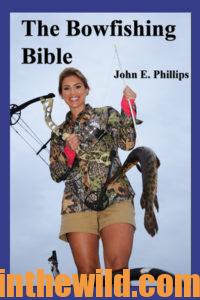 tournament for three years, and we got a first place and two, second places for all three years.
tournament for three years, and we got a first place and two, second places for all three years.
This was a strategic, logistic type of event where you had to shoot certain fish. We shot the fish that we could present the best on camera. Each team was given a cameraman, and he was more important than the shooters were. For the bowfishing team to get points, the cameraman had to capture the footage that included filming the fish in the water before the shot, filming the shot, and finally filming taking the fish out of the water and showing it to the cameraman. This task might seem easy, but most of the time, when you’re fishing at night, once the light hits the fish in the water, you have very little time to get the shot. So, most of the teams had a difficult time getting that footage of the fish in the water before they took the shot. The longer the cameraman could see the fish in the water before the shot, the more points you receive for taking that fish on video.
The secret we learned to get great video was to shoot bighead carp right at daylight when the sun was just starting to come up, and there was barely enough light for the cameraman to get footage of the fish in the water. We had 3 days, and we used that magic time right at daylight to take those bighead carp. Our cameraman was able to get footage of the fish with their mouths out of the water before we took the shot. We were able to film those carp in front of the boat for a good while before we shot them. Getting full credit for being able to video the fish before the shot was what helped us win that tournament. That footage was used on the Kip Campbell Red Arrow TV Show (www.redarrowtv.com). It was a different kind of bowfishing, it was really challenging, and I enjoyed it.
To learn more about bowfishing, check out John E. Phillips’ book, “The Bowfishing Bible,” available in Kindle and print versions at – http://amzn.to/22zX7Zz.

